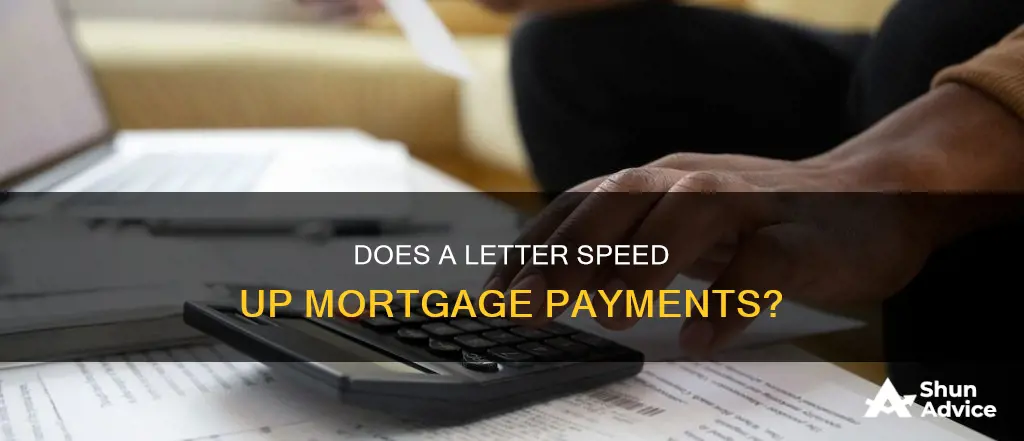
An acceleration clause is a provision in a mortgage agreement that defines when and how the lender can accelerate the full repayment of the loan. If a homeowner fails to fulfill the terms of their mortgage agreement, they will receive an acceleration letter, also known as a breach letter, notifying them that the lender has triggered the acceleration clause. This letter will include the reason for the mortgage acceleration, the lender's contact information, and the mortgage balance with any back interest owed. The letter will also request payment and specify a date by which the payment is due, which is usually 30 days after receiving the letter. While the language used in the letter ought not to be mysterious, a clear and unequivocal letter is required to accomplish mortgage acceleration.
| Characteristics | Values |
|---|---|
| What is a mortgage acceleration clause? | A provision in your mortgage agreement that defines when and how the lender can “accelerate” the full repayment of the loan. |
| What triggers an acceleration clause? | Missed mortgage payments, cancellation of homeowners insurance, failure to pay property taxes, bankruptcy, selling or transferring the property without permission, etc. |
| What happens when the clause is triggered? | The lender sends an acceleration letter, which outlines the amount owed, the deadline for payment, and the reason for the mortgage acceleration. |
| What to do if you receive an acceleration letter? | Contact your lender as soon as possible, explain your financial situation, and ask about mortgage assistance options. You may also seek advice from housing counselors through the Department of Housing and Urban Development (HUD). |
| How to avoid triggering the acceleration clause? | Make your required mortgage payments on time and in full, pay all homeownership costs, and maintain your property. |
| How to deaccelerate the mortgage? | The revocation of the acceleration clause is accomplished by an affirmative act on the lender's part, affording the borrower notice of the deacceleration. |
What You'll Learn

What is a mortgage acceleration clause?
A mortgage acceleration clause is a provision in a mortgage agreement that defines when and how the lender can "accelerate" the full repayment of the loan. An acceleration clause outlines the reasons that the lender can demand loan repayment and the repayment required. It is usually based on payment delinquencies but can be structured for other occurrences as well. For example, lenders may include a clause requiring the borrower to maintain a certain credit rating.
Acceleration clauses are most common in mortgage loans and help to mitigate the risk of default for the lender. They are typically contingent on timely payments, and lenders will usually wait until the third missed payment to send out an acceleration letter. This letter will include the reason for the mortgage acceleration, the lender's contact information, and the mortgage balance with any back interest owed. The letter will also request payment and specify a date by which the payment is due—usually 30 days after receiving the letter. If the borrower can pay off the outstanding balance, the lender no longer has a claim on the property.
If the borrower cannot pay the full amount, they are considered in breach of contract, and the lender can foreclose and seize the property for resale. However, foreclosure is a last resort, and there are other options available to borrowers. For example, borrowers may be able to reinstate the loan after acceleration or work out a loan modification or repayment plan with the lender to make up delinquent payments. It is essential to communicate with the lender as soon as issues with making payments arise and explain the situation to find a potential solution.
Florida Mortgage Witness Requirement: What You Need to Know
You may want to see also

When is a mortgage acceleration letter sent?
A mortgage acceleration letter, also known as a Notice of Acceleration, is sent by a lender to a borrower when they have failed to make their scheduled mortgage payments. This letter informs the borrower that the lender has triggered the acceleration clause in their mortgage contract. The acceleration clause is a provision in the mortgage agreement that defines when and how the lender can "accelerate" the full repayment of the loan.
The timeline for sending a mortgage acceleration letter varies among lenders, but it is usually sent after a certain number of missed payments. Some lenders may send the letter after one missed payment, while others may allow for two or three missed payments before sending the letter. The letter typically includes the reason for the mortgage acceleration, the lender's contact information, and the mortgage balance with any outstanding interest owed up to that point.
It is important to note that receiving a mortgage acceleration letter does not necessarily mean that foreclosure is inevitable. Borrowers may be able to work with their lender to develop a plan to catch up on their monthly payments and restore their mortgage. In some cases, a loan modification or repayment plan can be agreed upon to make up for the delinquent payments. However, it is crucial to act quickly and seek legal advice if necessary to understand your rights and options.
Additionally, there are other conditions that can trigger a mortgage acceleration clause besides payment delinquency. For example, selling or transferring the property without the lender's permission or cancelling homeowners insurance could result in the lender accelerating the loan. Therefore, it is important for borrowers to carefully read and understand all the terms and conditions of their mortgage agreement to avoid unintentionally triggering the acceleration clause.
Judgment Mortgages: Do They Expire or Persist?
You may want to see also

What should a mortgage acceleration letter include?
A mortgage acceleration letter is sent to a borrower when the lender has decided to trigger the acceleration clause. This clause is included in the mortgage contract and outlines the reasons and conditions under which the lender can demand immediate full repayment of the loan. Therefore, the content of the acceleration letter will be based on the specific acceleration clause in the mortgage contract.
The letter should include the reason for the mortgage acceleration, the lender's contact information, and the total mortgage balance, including any back interest owed. The letter will also specify a date by which the payment is due. The borrower has to pay back the full balance by the date mentioned in the letter to satisfy the loan.
The acceleration clause is usually triggered when the borrower misses a certain number of mortgage payments or cancels their homeowners' insurance. It can also be activated if the borrower transfers the property to another party without informing the lender, files for bankruptcy, or fails to pay property taxes.
It is important to note that even if the borrower receives the acceleration letter, they can still negotiate with the lender to find potential solutions, such as a loan modification or repayment plan. The borrower may also be eligible for mortgage forbearance, which temporarily pauses or reduces mortgage payments.
HELOCs: Mortgage, Note, and You
You may want to see also

How to avoid receiving a mortgage acceleration letter?
A mortgage acceleration letter is a document sent by the lender to the borrower when the mortgage acceleration clause in the loan agreement is triggered. This clause is a provision in the mortgage agreement that defines when and how the lender can "accelerate" the full repayment of the loan. The letter will include the reason for the mortgage acceleration, the lender's contact information, and the mortgage balance with any back interest owed. It will also specify a date by which the payment is due.
To avoid receiving such a letter, borrowers should make their mortgage payments on time and in full and follow the other terms of their loan. If a borrower anticipates issues with making payments or has another problem that could trigger the clause, they should communicate with their lender as soon as possible and explain their situation. Borrowers may be able to avoid acceleration by working out a loan modification or repayment plan with their lender to make up delinquent payments.
Even if a borrower triggers the clause and receives the acceleration letter, it is still possible to negotiate and work with the mortgage lender toward potential solutions. For example, refinancing to a loan with a lower interest rate can help lower monthly payments. Lenders may also be willing to accept a deed-in-lieu of foreclosure, which will keep the borrower from having foreclosure stamped on their credit report, although they will still be responsible for any difference between the property's value and the mortgage balance.
Joint Mortgage: Part of an Estate or Not?
You may want to see also

What to do if you receive a mortgage acceleration letter?
Receiving a mortgage acceleration letter can be distressing, but there are steps you can take to resolve the issue. Here is what you should do if you find yourself in this situation:
First, understand what a mortgage acceleration letter is and why you received it. A mortgage acceleration letter, also known as a breach letter, is a formal notice from your lender stating that you have violated the terms of your mortgage agreement, typically by failing to make payments on time. This letter informs you that the lender is invoking the acceleration clause in your mortgage contract, which means they are demanding immediate repayment of the full outstanding loan amount.
Review your mortgage agreement: Carefully read through your mortgage contract to understand the specific terms and conditions, including the acceleration clause. Look for any triggering terms or scenarios that could have led to the activation of the acceleration clause.
Contact your lender: Get in touch with your lender as soon as possible. Communicate your situation and try to work together to find a solution. Lenders are often willing to negotiate and may be open to alternative arrangements, such as a loan modification or repayment plan, to help you get back on track with your payments.
Seek legal advice: Consult with a real estate attorney or the attorney who handled your closing to review the acceleration clause and advise you on your legal options. They can explain the legality of the clause and help you understand your rights, especially if you believe the acceleration letter has been sent in error.
Explore your financial options: If you are unable to make the full repayment immediately, consider your financial alternatives. You may be able to refinance your mortgage, take out a new loan, or access other sources of funds to negotiate a settlement with your lender.
Stay calm and proactive: Receiving a mortgage acceleration letter can be a worrying experience, but it's important not to panic. Take a proactive approach by responding promptly, exploring your options, and communicating openly with your lender and legal advisors.
Remember, even if you receive an acceleration letter, it is not the end of the road. You have rights and options to resolve the issue and avoid foreclosure. By taking swift and informed action, you can work towards finding a solution that satisfies both you and your lender.
HOA Lien Foreclosure: Can It Wipe Out Your Mortgage?
You may want to see also
Frequently asked questions
An acceleration clause is a provision in your mortgage agreement that defines when and how the lender can “accelerate” the full repayment of the loan. It is usually based on payment delinquencies but can be structured for other occurrences as well.
The borrower is required to pay the entire balance in full, agree to a short sale or home transfer, or enter the foreclosure process. The borrower may also have options to reinstate the loan after acceleration.
Contact your lender as soon as you can and explain your financial situation. They will be able to detail what mortgage assistance options they can offer to help you avoid foreclosure.
The most common reason is when the borrower doesn't make the required payments. Other reasons include selling or transferring the property without permission, failure to pay property taxes, and bankruptcy.
Yes, a letter can be used to de-accelerate a mortgage. A clear, unequivocal letter to the borrower can be used to revoke acceleration of the mortgage debt.







